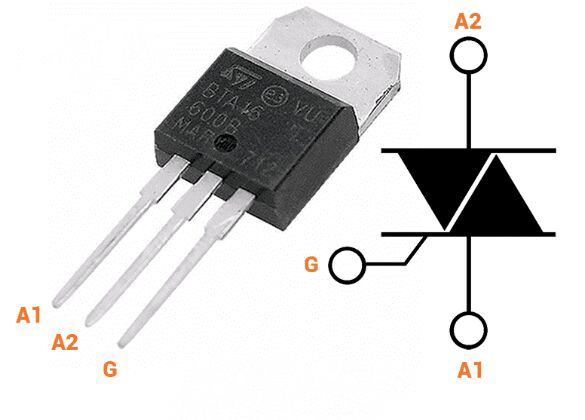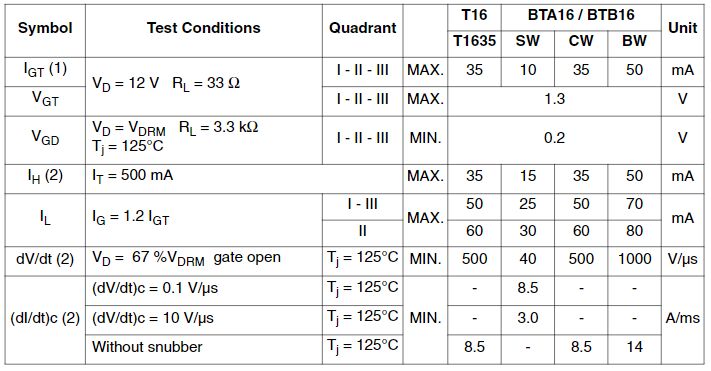By STMicroelectronics 267
BTA16-600B generally refers to thyristor. Silicon Controlled Rectifier, referred to as SCR, is a high-power electrical component, also known as thyristor. It has the advantages of small size, high efficiency and long life. In automatic control systems, it can be used as a high-power driving device to control high-power equipment with low-power controls.
BTA16-600B is a bidirectional thyristor, also known as Triac. Triac is an electronic component used for current control in AC circuits. The "16" in the model number of BTA16-600B indicates its rated current, while the "600" indicates its rated voltage.

Ⅰ.Specifications of BTA16-600B
•Number of pins:3
•Moisture Sensitivity Level (MSL):1(no limit)
•Non-repetitive on-state current:170 A
•On state voltage:1.6 V
•Rated repetitive off-state voltage VDRM:600 V
•Off-state leakage current(at VDRM IDRM):5 uA
•Maximum holding current Ih:50 mA
•Gate trigger voltage-Vgt:1.5 V
•Gate trigger current-Igt:100 mA
•Minimum operating temperature:-40℃
•Maximum operating temperature:+125 degrees Celsius
•Installation style:Through Hole
•RMS current (Irms):16A
•Leakage current (maximum):2mA
•Triac Type:Standard
Ⅱ.The role of BTA16-600B
1.BTA16-600B is a high-power Triac (bidirectional thyristor), which can be used to control the current in AC circuits. By applying an appropriate voltage pulse to the control terminal (Gate) of the TIiac, the riac can be turned on, allowing current to flow. This characteristic makes the BTA16-600B very useful in home appliances, lighting systems and other fields. A triac works like a normal diode, but it is bidirectional and can conduct in both directions. When a positive pulse is applied to the Gate terminal, the Triac will conduct during the positive half cycle, allowing current to pass. Therefore, by controlling the voltage pulse at the Gate terminal, the switching time and size of the current can be controlled.
2.Power tool speed control: In some power tools, Triac can be used to adjust the speed of the motor to achieve the speed control function.
3.AC dimming: Triac is widely used in AC dimming systems, in which the brightness of the light can be adjusted by controlling the conduction angle of the Triac. This is accomplished by changing the phase of the alternating current. In an AC circuit, current flows in both the positive and negative half cycles. The conduction of Triac occurs in the positive half cycle, so the size of the current and the brightness of the light can be controlled by controlling the time during which the Triac conducts in the positive half cycle, that is, by controlling the conduction angle. Specifically, by applying a suitable voltage pulse to the Gate terminal of the Triac, the conduction of the Triac in the positive half cycle can be triggered. Changing the amplitude and width of the voltage pulse can control the conduction time and current size of the Triac, thereby changing the brightness of the light.
4.Electric furnace temperature control: In heating equipment such as electric furnaces, BTA16-600B can be used to control the current of the heating element to achieve temperature control. In heating equipment such as electric furnaces, heating elements (such as electric heating wires) will generate heat to increase the temperature in the furnace. By applying an appropriate voltage pulse to the Gate terminal of BTA16-600B, the current of the heating element can be controlled, thereby controlling The heat generated and the temperature inside the furnace. By adjusting the amplitude and width of the voltage pulse, the current size and on-off time of the heating element can be controlled, thereby achieving precise temperature control. This temperature control method is widely used in various electric stoves, ovens, water heaters and other heating equipment.
5.Switch in AC circuit: Triac can be used as a switch in AC circuit to allow or prohibit the flow of current.
Ⅲ.Absolute Maximum Ratings of BTA16-600B

Ⅳ.Electrical Characteristics of BTA16-600B(Tj = 25°C,unless otherwise specified)

Ⅴ.Correctly drive and trigger BTA16-600B
1.Source of control signal: The control of BTA16-600B is through the Gate (G) pin. In order to trigger the Triac, an appropriate voltage pulse needs to be applied to the Gate pin. This voltage pulse usually comes from a control circuit such as a microcontroller, flip-flop, or other suitable signal source.
2.Trigger current: The Gate Trigger Current of BTA16-600B refers to the minimum current required by the trigger to ensure reliable triggering. Likewise, make sure your control circuit can provide enough current to trigger the triac.
3.Voltage pulse characteristics: The control signal should be a narrow pulse with a high enough amplitude to ensure reliable triggering. Usually, the Gate Trigger Voltage of BTA16-600B is specified in the data sheet. Make sure your control circuit generates a pulse voltage higher than this trigger voltage.
4.Isolation: If the control circuit and the controlled circuit are in different electrical systems or voltage levels, you should consider using isolation devices such as optocouplers to ensure safe isolation.
5.Impedance matching: An appropriate resistor may be required between the Gate pin and the trigger circuit to ensure the impedance matching of the signal. This helps improve system stability and reliability.
6.Current path: Make sure the current flows through the Triac in the direction from MT2 to MT1, which is the conduction direction of the Triac.
7.Temperature considerations: The triggering characteristics of the Triac may be affected by temperature, so the temperature range of the working environment must be considered in the design.
Ⅵ.Replacement model of BTA16-600B
1.BTA16-600BW: This is another packaging form of the same series of BTA16-600B, which can be considered as an alternative.
2.BTB16-600B: This is a Triac produced by STMicroelectronics. It is similar to BTA16-600B in some parameters and can be used as a potential replacement.
3.MAC97A6: This is a bidirectional thyristor produced by STMicroelectronics. It is similar to the BTA16 series in some parameters.
4.Z0103MN: This is a Triac produced by STMicroelectronics and is suitable for low power applications.
5.TIC226M: This is a product of STMicroelectronics. It is also a bidirectional thyristor and may be suitable for some similar applications.
Ⅶ.Advantages of BTA16-600B
•Bidirectional control: Triac is a triac that can control the current in both the positive and negative half cycles, making it very useful in AC circuits.
•Wide application: Due to its wide application in home appliances, lighting systems, electric stoves, etc., BTA16-600B has a wide range of markets and application fields.
•AC current control: BTA16-600B allows precise control of AC current and is therefore common in applications requiring dimming, temperature control, etc.
•Dimming function: BTA16-600B is often used to realize the dimming function of AC lights in lighting systems, and adjusts the brightness of the light by controlling the conduction angle of the Triac.
•Simplified circuit: Triac can often be used to replace mechanical switches, thereby simplifying circuit design and improving reliability.
•Current Protection: Triac can improve system safety by adding appropriate current protection to the control circuit.
•Reliability: As a solid-state device, a Triac is generally more reliable than some mechanical switches because it has no moving parts and has a longer life.
Frequently Asked Questions
1.What is the function of BTA16-600B?
The BTA16-600BRG is a 3-pin Snubberless Insulated TRIAC for general purpose AC switching and can be used as an ON/OFF function. The BTA series TRIAC provides a voltage insulated tab by using an internal ceramic pad.
2.How to use BTA16-600B reasonably when designing circuits?
Design a suitable trigger circuit to ensure reliable triggering of the BTA16-600B. Consider the trigger current and trigger voltage requirements and use appropriate components to provide the control signal. If the control circuit and the controlled circuit are on different electrical systems or voltage levels, use appropriate isolation devices, such as optocouplers, to ensure circuit safety.
3.What applications is BTA16-600B usually used for?
Lighting systems, AC power controls, electric furnace and heating controls, AC circuit switches, electric furnace and heating controls, power tool speed controls, home appliance controls.
4.What precautions should be taken when driving and triggering the BTA16-600B?
Properly driving and triggering the BTA16-600B involves considerations like gate trigger voltage, gate trigger current, and isolation. It's important to design a suitable trigger circuit and ensure proper isolation for safety.